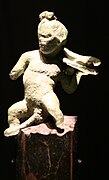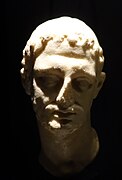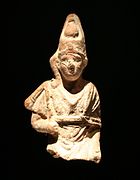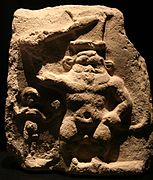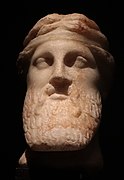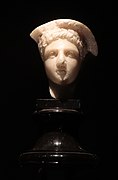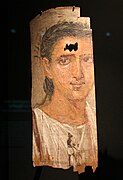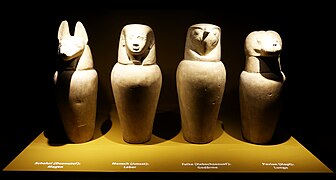Sieglin Collection
The Ernst von Sieglin Collection is a collection of objects from Pharaonic and Greco-Roman Egypt within the Württemberg State Museum .
history
Initiator was the patron Ernst von Sieglin which until 1902 in the range of in 1898 Alexandria by the Leipzig Egyptologists Theodor Schreiber make extensive excavations, especially in the most important Roman had necropolis in ancient Egypt, Kôm-Esch-Schukâfa, the Serapeion on the area of the Royal Palace and in the Hadra district. After completing the work, Sieglin donated some of the objects to the cultural institutions of his home country, Kingdom of Württemberg . A second expedition took place from 1909 to 1914. Under the direction of the Leipzig Egyptologist Georg Steindorff , the mortuary temple of Chephren, east of the second largest pyramid in Giza, was uncovered from 1909 to 1914. Also in Giza came the grave of Seschemnofers, a high official who lived around 2350 BC. BC lived to the surface. Through excavations and acquisitions, Sieglin came into possession of a large collection, which he donated to the King of Württemberg, the universities of Tübingen and Leipzig and the Albertinum in Dresden while he was still alive.
The collection
The collection items are now in the Württemberg State Museum in Stuttgart, in the Museum of the University of Tübingen, in the Albertinum in Dresden and at the University of Leipzig.
The provenance of the finds can be proven on the basis of the diary entries and inscriptions of the classical archaeologist Rudolf Pagenstecher . He measured the pieces and made small drawings of them. The indications of origin and probes do not indicate the exact location and position of the respective find, but they limit the finds to the respective urban area of Alexandria. The concordance list according to Laube includes 66 plants for Tübingen, 46 for Stuttgart and 150 for Dresden.
Within the State Museum of Württemberg, the Sieglin Collection is shown in a round pavilion of the Antikensammlung on the first floor of the Old Palace in Stuttgart , albeit only a fraction of the museum's collection. Small figures made of terracotta and bronze as well as marble sculptures are particularly common in the collection .
Exhibited objects
The 59 exhibited objects from the Sieglin Collection are presented in 12 showcases inside the round black pavilion in the antique collection of the Württemberg State Museum. The showcases are counted from left to right from the entrance. A portrait relief by Ernst von Sieglin hangs between showcase 4 and 5 (see cover picture).
Showcase 1: caricatures and grotesques
The terms caricatures and grotesques cannot always be sharply separated. They include "an abundance of different types, which are characterized by physical deformations of all kinds, fantastic body features and caricatured or exaggerated facial features."
|
|
|
|
|
1. Old woman with an elaborate hairstyle. 2. Whistling bald man. 3. Man with wreaths and negroid features. 4. Man with curly hair and a nose ring. 5. Lamp with boys with negroid features. 6. Slave with oversized phallus and shouldered amphora. 7. Old woman with wreath. 8. Dancing dwarf with a wreath. 9. Crippled fish seller with a large phallus. 10. Hunchback. 11. Actor in the role of the slave of the New Comedy. 12. Theater mask of the brothel keeper of the New Comedy. 13. Theater mask of the New Comedy. 14. Actors of the Old Comedy. |
Showcase 2: portraits of rulers
|
|
|
1. Portrait of Alexander the Great. 2nd back. 3. Portrait of Pompey the Great. 4. Back. |
Showcase 3: Ptolemaic portraits
|
|
|
1. Bust of Alexander the Great with a crown of gods and ram horns. 2. Ptolemy IX's head with tiara. 3rd group of wrestlers. 4. Portrait of a Ptolemy with a diadem. 5. Ptolemy jug with Arsinoe III., Wife of Ptolemy IV. 6. Ptolemy as Isis. 7. Head with Isis curls (Ptolemy?). |
Showcase 4: portraits of rulers
|
|
|
1. Portrait of Alexander the Great. 2. Portrait of Augustus reworked from a Ptolemy portrait. |
Showcase 5: world of gods
|
|
|
1. Isis with the Horus boy. 2. Statuette of Harpokrates-Osiris. 3. Statuette of Harpocrates. 4. Statuette of Isis-Bubastis. 5. Statuette of Isis-Aphrodite. 6. Osiris Canopus. 7. Statuette of Bes. 8. Bes relief. |
Showcase 6: world of gods
|
|
|
1. Head of Dionysus. 2. Aphrodite and Eros. 3. Head of Hermes. 4. Head of Poseidon. 5. Hermaphroditus. 6. Elephant exuvie . 7. Bearing Nile. |
Showcase 7: Ptolemaic portrait
Head part of a statue from Buto in the Nile Delta. The showcase shows the front of the head and on the other side the back with the end of the back pillar of the statue.
|
|
|
1. Head part of a statue. 2. Back of the headboard with part of the back pillar. |
Showcase 8: Ptolemaic cults
Serapis was a god who was established as an imperial god under the Ptolemies . In it, Egyptian and Greco-Roman main deities merged. The most important god of the Ptolemies was Dionysus , the god of wine and theater. To his admiration Ptolemy IV. Philopator founded the bottle festival (Lagynophorien), to which everyone brought his bottle (Lagynos) and his food.
|
|
|
1. Relief of Serapis. 2. Statuette of Serapis. 3. Hunchback with Lagynos and Hahn. 4. Lagynos. 5. Head of Dionysus. |
Showcase 9: Mummy portrait
Mummy portraits are painted portraits that are applied to thin wooden panels and integrated into the headboard of mummies. The illustration shows the mummy portrait of Eirene, who bears the inscription on her neck: “Eirene, daughter of Silvanos, her mother is Senpnoutis. May her soul live before Osiris Sokaris, the great god, Lord of Abydos, forever. "
|
|
Showcase 10: Mummy portraits
Mummy portraits are painted portraits that are applied to thin wooden panels and integrated into the headboard of mummies.
|
|
|
1. Mummy portrait of a boy. 2. Mummy portrait of a man. 3. Mummy portrait of a young woman. 4. Mummy portrait of a woman, fragment. |
Showcase 11: mummy masks
Mummy masks are painted masks that were attached to the head of the mummies but did not cover the mummy's face. The masks shown were made of stucco.
|
|
|
1. Mummy mask of a woman. 2. A man's mummy mask. 3. Mummy mask of a woman. 4. Mummy mask of a woman. 5. A man's mummy mask. |
Showcase 12: jars
In ancient Egypt, before a corpse was mummified, the intestines of the stomach, liver, intestines and lungs were removed and buried in ceramic jugs, the canopic jars. The heads of the protective gods of the four organs were depicted on the lids of the canopic jars: Duamutef as a jackal for the stomach, Amset as a human being for the liver, Kebechsenuef as a falcon for the intestines and Hapi as a baboon for the lungs.
|
|
|
1. Jackal (Duamutef): stomach. 2. Human (Amset): liver. 3. Falcon (Kebechsenuef): intestines. 4. Baboon (Hapi): lungs. |
literature
- Jutta Fischer: Greco-Roman terracottas from Egypt: the Sieglin and Schreiber collections, Dresden, Leipzig, Stuttgart, Tübingen. Tübingen: Wasmuth, 1994.
- Ingrid Laube: Sculpture of Hellenism and the Imperial Era from Egypt: Expedition Ernst von Sieglin; the collections in Dresden, Stuttgart and Tübingen. Munich: Hirmer, 2012, ISBN 978-3-7774-5691-1 .
- Nina Willburger: Evidence of Roman mummy decoration from Egypt. Ernst von Sieglin and his collection. In: Daniel von Recklinghausen (editor): Egyptian mummies: Immortality in the land of the pharaohs. Large state exhibition in Baden-Württemberg. Mainz: von Zabern, 2007, pages 228-254.
- Greece and Rome in Egypt - Ernst von Sieglin and his collection. In: Nina Willburger: True Treasures: Antiquity. With contributions by Sabrina Feickert and Veronika Lobe. Ulm: Süddeutsche publishing company in January Thorbecke Verlag, 2016, ISBN 978-3-7995-1140-7 , page 51-59.
Web links
- Landesmuseum Württemberg, digital catalog , search term: Sieglin.
Individual evidence
- ↑ #Laube 2012 , page 50.
- ↑ #Laube 2012 , pages 376–378.
- ↑ # Fischer 1994 , page 51.









